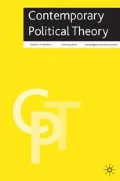Abstract
This article explores the political meanings of a relatively unexplored dimension of Edmund Burke's thought: the monster. After first showing the extent to which the figure of the monster appears throughout Burke's work, the article speculates on some of the political reasons for Burke's use of the metaphor of the monstrous. These reasons are rooted in the categories of the aesthetic developed in the Philosophical Enquiry into the Origin of our Ideas of the Sublime and Beautiful, and also in his political fear of a new collective entity only beginning to emerge on the historical stage: the proletariat. The article therefore has three aims: first, to contribute to the developing body of literature on Burke's aesthetic ideology; second, to deepen our knowledge of the Gothic tropes in Burke's writings; and third, to broaden our conception of the way conservative ideology conceptualizes order and the threats to that order.
Author information
Authors and Affiliations
Rights and permissions
About this article
Cite this article
Neocleous, M. The Monstrous Multitude: Edmund Burke's Political Teratology. Contemp Polit Theory 3, 70–88 (2004). https://doi.org/10.1057/palgrave.cpt.9300110
Received:
Accepted:
Published:
Issue Date:
DOI: https://doi.org/10.1057/palgrave.cpt.9300110

